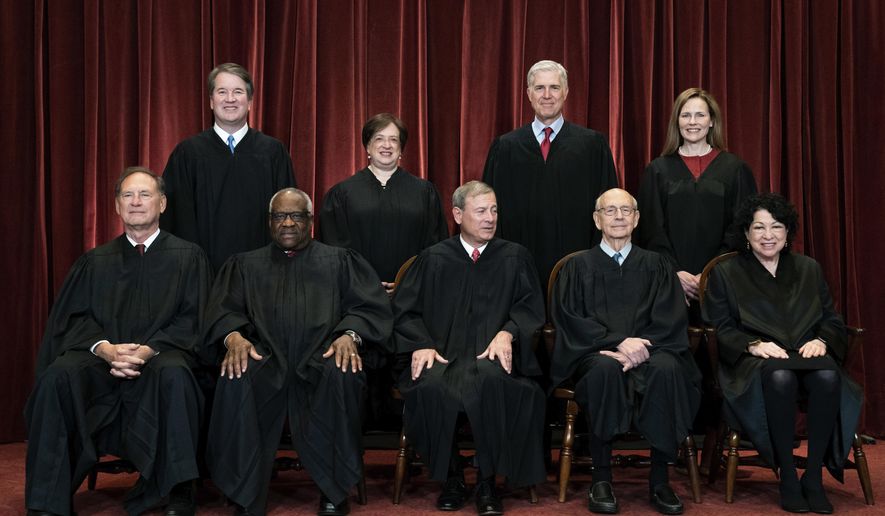OPINION:
Editor’s note: This is one in a series examining the Constitution and Federalist Papers in today’s America.
The recently completed term of the U.S. Supreme Court was perhaps the most extraordinary one in memory. The high court addressed numerous constitutional issues, including the scope of the Second Amendment, religious freedom, the reach of the administrative state and, perhaps most importantly, the question of which level of government should regulate abortion.
Given the constitutional, social and political significance of the court’s decision in Dobbs v. Jackson Women’s Health Organization, in which the high court overturned Roe v. Wade and upended 50 years of precedent, the majority opinion written by Justice Samuel A. Alito Jr. and the concurrence written by Justice Brett M. Kavanaugh are worth reading.
Below are some of the highlights of Justice Alito’s majority opinion:
“An erroneous interpretation of the Constitution is always important, but some are more damaging than others. The infamous decision in Plessy v. Ferguson, was one such decision. It betrayed our commitment to ‘equality before the law.’”
“Roe was also egregiously wrong and deeply damaging. … Roe’s constitutional analysis was far outside the bounds of any reasonable interpretation of the various constitutional provisions to which it vaguely pointed.”
“Roe was on a collision course with the Constitution from the day it was decided. Casey perpetuated its errors, and those errors do not concern some arcane corner of the law of little importance to the American people. Rather, wielding nothing but ‘raw judicial power,’ the court usurped the power to address a question of profound moral and social importance that the Constitution unequivocally leaves for the people.”
“As Justice [Byron] White later explained, ‘decisions that find in the Constitution principles or values that cannot fairly be read into that document usurp the people’s authority, for such decisions represent choices that the people have never made and that they cannot disavow through corrective legislation.’”
Justice Alito also points out that on the morning of Jan. 22, 1972, every state considered abortion illegal in some or all circumstances.
“This overwhelming consensus endured until the day Roe was decided. At that time, also by the Roe court’s own count, a substantial majority — 30 states — still prohibited abortion at all stages except to save the life of the mother. And though Roe discerned a ‘trend toward liberalization’ in about ‘one-third of the states,’ those states still criminalized some abortions and regulated them more stringently than Roe would allow.”
“It follows that the states may regulate abortion for legitimate reasons, and when such regulations are challenged under the Constitution, courts cannot ‘substitute their social and economic beliefs for the judgment of legislative bodies.’”
“We therefore hold that the Constitution does not confer a right to abortion. Roe and Casey must be overruled, and the authority to regulate abortion must be returned to the people and their elected representatives.”
In concurrence, Justice Kavanaugh sharpened some of the points in the majority opinion.
“The issue before this court, however, is not the policy or morality of abortion. The issue before this court is what the Constitution says about abortion. The Constitution does not take sides on the issue of abortion. The text of the Constitution does not refer to or encompass abortion. To be sure, this court has held that the Constitution protects unenumerated rights that are deeply rooted in this nation’s history and tradition, and implicit in the concept of ordered liberty. But a right to abortion is not deeply rooted in American history and tradition, as the court today thoroughly explains.”
Justice Kavanaugh’s footnote on this history reads in part: “As I see it, the dispositive point in analyzing American history and tradition for purposes of the 14th Amendment inquiry is that abortion was largely prohibited in most American states as of 1868 when the 14th Amendment was ratified, and that abortion remained largely prohibited in most American states until Roe was decided in 1973.”
“On the question of abortion, the Constitution is therefore neither pro-life nor pro-choice. The Constitution is neutral and leaves the issue for the people and their elected representatives to resolve through the democratic process in the states or Congress — like the numerous other difficult questions of American social and economic policy that the Constitution does not address.”
“Because the Constitution is neutral on the issue of abortion, this court also must be scrupulously neutral. The nine unelected members of this court do not possess the constitutional authority to override the democratic process and to decree either a pro-life or a pro-choice abortion policy for all 330 million people in the United States.”
• Michael McKenna is the co-host of “The Unregulated” podcast. He was most recently a deputy assistant to the president and deputy director of the Office of Legislative Affairs at the White House. He can be reached at mike@mwrstrat.com.





Please read our comment policy before commenting.